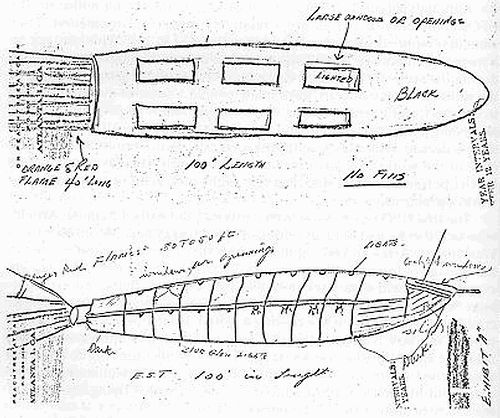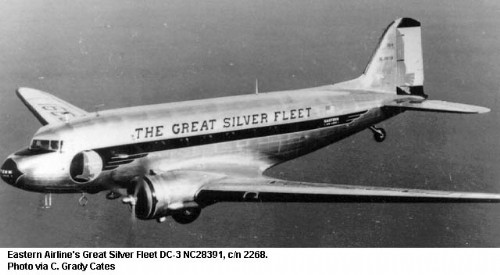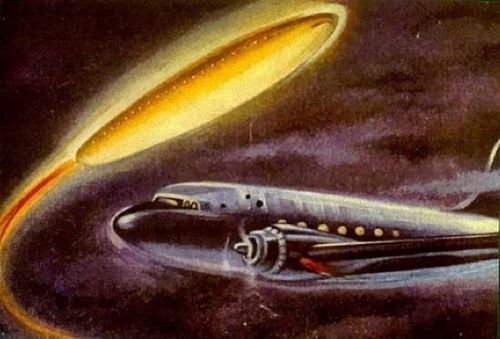UFO Case Report:
The Chiles-Whitted Case
Date: July 24, 1948
Location: Montgomery, Alabama, United States
Another one of the famous airline sightings of earlier years is the Chiles-Whitted Eastern Airlines case. An Eastern DC-3, en route from Houston to Atlanta, was flying at an altitude of about 5,000 ft.. near Montgomery. ...The object was some kind of vehicle. They saw no wings or empennage, but both were struck by a pair of rows of windows or some apparent openings from which there came a bright glow "like burning magnesium."

Witness sketches of object.

DC-3 airplane (Eastern Airlines).

Artist depiction of incident.
Classification & Features
Type of Case/Report: MajorCase
Hynek Classification: DD
# of Witnesses: Multiple
Special Features/Characteristics: Pilot/Aircrew, Witness Sketch, Portholes/Windows
More Articles on this Case
Chiles-Whitted Case Report
Captain Edward J. Ruppelt
On the evening of July 24, 1948, an Eastern Airlines DC-3 took off from Houston, Texas. At about 2:45 A.M., when the flight was 20 miles southwest of Montgomery, the captain, Chiles, saw a light dead ahead and closing fast. R
Chiles-Whitted Case Directory
NICAP
Eastern Airlines pilots, Captain C.S. Chiles and First Officer J.B. Whitted, reported that a cigar-shaped object with lights like portholes approached head-on, accelerated, climbed away. Collection of reports and documents from NICAP.
Chiles-Whitted Air Intelligence Report
U.S. Air Force Intelligence, 1949
Excerpt from a U.S. Air Force Air Intelligence Report on the Chiles-Whitted incident.
Project Blue Book: Chiles-Whitted Case File
Project Blue Book Archive
The original scanned microfilm case folder from USAF Project Blue Book.
Full Report / Article
Source: Dr. James E. McDonald, U.S. House Hearings, 1968
[go to original source]
Another one of the famous airline sightings of earlier years is the Chiles-Whitted Eastern Airlines case (Refs. 3, 5, G , 10, 23, 24, 25, 26). An Eastern DC-3, en route from Houston to Atlanta, was flying at an altitude of about 5,000 ft.. near Montgomery at 2 :45 a.m. The pilot, Capt. Clarence S. Chiles, and the co-pilot, John B. Whitted, both of whom now fly jets for Eastern, were experienced fliers (for example, Chiles then had 8500 hours in the air, and both had wartime military flying duty behind them.). I interviewed both Chiles and Whitted earlier this year to crosscheck the many points of interests in this case. Space precludes a full account of all relevant details.
Chiles pointed out to me that they first saw the object coming out of a distant squall line area which they were just reconnoitering. At first, they thought it was a jet, whose exhaust was somehow accounting for the advancing glow that had first caught their eyes. Coming almost directly at them at nearly their flight altitude, it passed off their starboard wing at a distance on which the two men could not closely agree: one felt it was under 1000 ft., the other put it at several times that. But both agreed, then and in my 1968 interview, that the object was some kind of vehicle. They saw no wings or empennage, but both were struck by a pair of rows of windows or some apparent openings from which there came a bright glow "like burning magnesium." The object had a pointed "nose", and from the nose to the rear along its underside there was a bluish glow. Out of the rear end came an orange-red exhaust or wake that extended back by about the same distance as the object's length. The two men agreed that its size approximated that of a B-29, though perhaps twice as thick. Their uncertainty as to true distance, of course, renders this only a rough impression. There is uncertainty in the record, and in their respective recollections, as to whether their DC-3 was rocked by something like a wake. Perception of such an effect would have been masked by Chiles' spontaneous reaction of turning the DC-3 off to the left as the object came in on their right. Both saw it pass aft of them and do an abrupt pull-up; but only Whitted, on the right side, saw the terminal phase in which the object disappeared after a short but fast vertical ascent. By "disappeared", Whitted made clear to me that he meant just that; earlier interrogations evidently construed this to mean "disappeared aloft" or into the broken cloud deck that lay above them. Whitted said that was not so; the object vanished instantaneously after its sharp pull-up. (This is not an isolated instance of abrupt disappearance. Obviously I cannot account for such cases.)
Discussion. This case has been the subject of much comment over the years, and rightly so. Menzel (Ref. 24) first proposed that this was a "mirage", but gave no basis for such an unreasonable interpretation. The large azimuth-change of the pilots' line of sight, the lack of any obvious light source to provide a basis for the rather detailed structure of what was seen, the sharp pull-up, and the high flight altitude involved all argue quite strongly against such a casual disposition of the case. In his second book, Menzel (Ref. 25) shifts to the explanation that they had obviously seen a meteor. A horizontally-moving fireball under a cloud-deck, at 5000 ft., exhibiting two rows of lights construed by experienced pilots as ports, and finally executing a most non-ballistic 90-degree sharp pull-up, is a strange fireball indeed. Menzels 1963 explanation is even more objectionable, in that he implies, via a page of side-discussion, that the Eastern pilots had seen a fireball from the Delta Aquarid meteor stream. As I have pointed out elsewhere (Ref. 2), the radiant of that stream was well over 90-degrees away from the origin point of the unknown object. Also, bright fireballs are, with only rare exceptions, not typical of meteor streams. The official explanation was shifted recently from "Unidentified" to "Meteor", following publication of Menzel's 1963 discussion (see Ref. 20, p.88).
Wingless, cigar-shaped or "rocket-shaped" objects, some emitting glowing wakes, have been reported by other witnesses. Thus, Air Force Capt. Jack Puckett, flying near 4000 ft. over Tampa in a C-47 on August 1, 1946 (Ref. 10, p.23), described seeing "a long, cylindrical shape approximately twice the size of a B-29 with luminous portholes", from the aft end of which there came a stream of fire as it flew near his aircraft. Puckett states that he, his copilot, Lt. H. F. Glass, and the flight engineer also saw it as it came in to within an estimated 1000 yards before veering off. Another somewhat similar airborne sighting, made in January 22, 1956 by TWA Flight Engineer Robert Mueller at night over New Orleans, is on record (Ref. 27). Still another similar sighting is the AAL case cited below (Sperry case). Again, over Truk Is., in the Pacific, a Feb. 6, 1953, mid-day sighting by a weather officer involved a bullet-shaped object without wings or tail (Ref. 7, Rept. No.10). Finally, within an hour's time of the Chiles-Whitted sighting, Air Force ground personnel at Robins AFB, Georgia, saw a rocket-like object shoot overhead in a westerly direction (Refs. 3, 5, 10, 6). In none of these instances does a meteorological or astronomical explanation suffice to explain the sightings.
Source: Dr. James E. McDonald, Prepared Statement on Unidentified Flying Objects, Page 42-43, Hearings, 1968.
Case ID: 116
edit: 116
FAIR
USE NOTICE: This page may contain copyrighted material the
use of which has not been specifically authorized by the
copyright owner. This website distributes this material without
profit to those who have expressed a prior interest in receiving
the included information for scientific, research and educational
purposes. We believe this constitutes a fair use of any such
copyrighted material as provided for in 17 U.S.C § 107.





